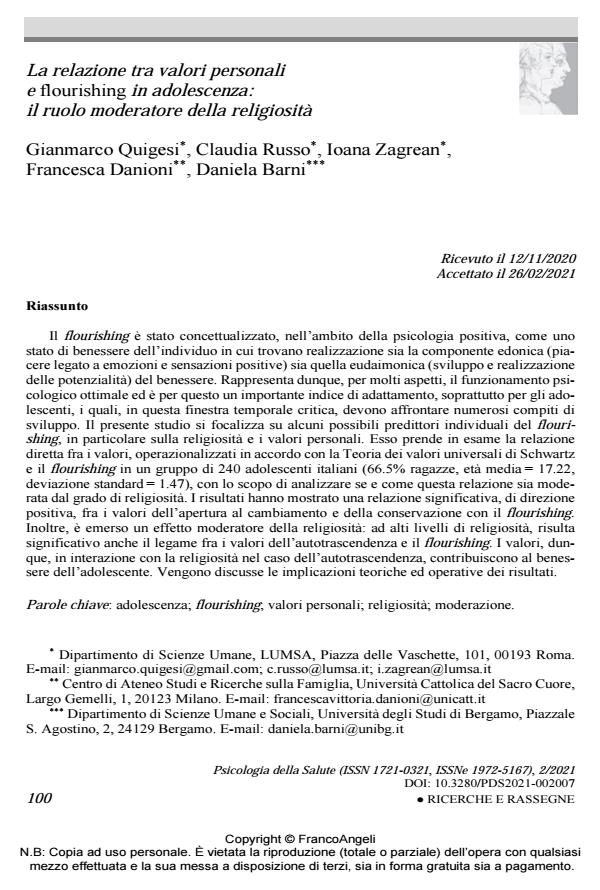La relazione tra valori personali e flourishing in adolescenza: il ruolo moderatore della religiosità
Titolo Rivista PSICOLOGIA DELLA SALUTE
Autori/Curatori Gianmarco Quigesi, Claudia Russo, Ioana Zagrean, Francesca Danioni, Daniela Barni
Anno di pubblicazione 2021 Fascicolo 2021/2
Lingua Italiano Numero pagine 17 P. 100-116 Dimensione file 323 KB
DOI 10.3280/PDS2021-002007
Il DOI è il codice a barre della proprietà intellettuale: per saperne di più
clicca qui
Qui sotto puoi vedere in anteprima la prima pagina di questo articolo.
Se questo articolo ti interessa, lo puoi acquistare (e scaricare in formato pdf) seguendo le facili indicazioni per acquistare il download credit. Acquista Download Credits per scaricare questo Articolo in formato PDF

FrancoAngeli è membro della Publishers International Linking Association, Inc (PILA)associazione indipendente e non profit per facilitare (attraverso i servizi tecnologici implementati da CrossRef.org) l’accesso degli studiosi ai contenuti digitali nelle pubblicazioni professionali e scientifiche
Il flourishing è stato concettualizzato, nell’ambito della psicologia positiva, come uno stato di benessere dell’individuo in cui trovano realizzazione sia la componente edonica (piacere le-gato a emozioni e sensazioni positive) sia quella eudaimonica (sviluppo e realizzazione delle potenzialità) del benessere. Rappresenta dunque, per molti aspetti, il funzionamento psicologi-co ottimale ed è per questo un importante indice di adattamento, soprattutto per gli adolescenti, i quali, in questa finestra temporale critica, devono affrontare numerosi compiti di sviluppo. Il presente studio si focalizza su alcuni possibili predittori individuali del flourishing, in partico-lare sulla religiosità e i valori personali. Esso prende in esame la relazione diretta fra i valori, operazionalizzati in accordo con la Teoria dei valori universali di Schwartz e il flourishing in un gruppo di 240 adolescenti italiani (66.5% ragazze, età media = 17.22, deviazione standard = 1.47), con lo scopo di analizzare se e come questa relazione sia moderata dal grado di religiosi-tà. I risultati hanno mostrato una relazione significativa, di direzione positiva, fra i valori dell’apertura al cambiamento e della conservazione con il flourishing. Inoltre, è emerso un ef-fetto moderatore della religiosità: ad alti livelli di religiosità, risulta significativo anche il legame fra i valori dell’autotrascendenza e il flourishing. I valori, dunque, in interazione con la religio-sità nel caso dell’autotrascendenza, contribuiscono al benessere dell’adolescente. Vengono discusse le implicazioni teoriche ed operative dei risultati.
Parole chiave:Adolescenza; flourishing; valori personali; religiosità; moderazione.
Gianmarco Quigesi, Claudia Russo, Ioana Zagrean, Francesca Danioni, Daniela Barni, La relazione tra valori personali e flourishing in adolescenza: il ruolo moderatore della religiosità in "PSICOLOGIA DELLA SALUTE" 2/2021, pp 100-116, DOI: 10.3280/PDS2021-002007